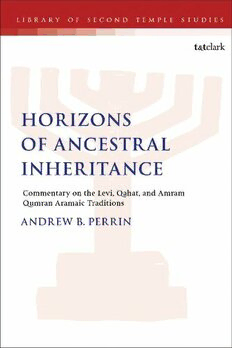
Horizons of Ancestral Inheritance: Commentary on the Levi, Qahat, and Amram Qumran Aramaic Traditions PDF
266 Pages·2022·11.539 MB·English
Most books are stored in the elastic cloud where traffic is expensive. For this reason, we have a limit on daily download.
Preview Horizons of Ancestral Inheritance: Commentary on the Levi, Qahat, and Amram Qumran Aramaic Traditions
Description:
In this study of the Aramaic materials at Qumran, Andrew B. Perrin examines the Aramaic Levi Document, Words of Qahat, and Visions of Amram, showing how they exhibit a concentration of priestly concerns/knowledge and exploring new models for evaluating their potential textual or traditional connections. The Aramaic texts among the Dead Sea Scrolls are among the most understudied items in the Qumran collection, and with open questions posed around their origins, transmission, and reception in and beyond the Second Temple period, these writings provide both new materials and fresh insight into the thought, identity, and practice of ancient Judaism.Perrin’s analysis includes a new transcription, critical notes, and translation of the Aramaic Levi, Qahat, and Amram fragments based upon the latest digital images. He pairs them with a comprehensive commentary on the conceptual elements, codicological features, and cultural contexts of the materials, and he concludes with a fresh synthesis regarding the textual formation of these Aramaic, priestly pseudepigrapha as a “constellation” of texts within a larger world or scribal-priestly activity and traditions.
See more
The list of books you might like
Most books are stored in the elastic cloud where traffic is expensive. For this reason, we have a limit on daily download.
